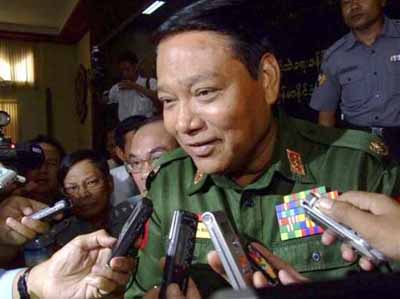Explosive Uncertainty

A series of bombings earlier this year has revived memories of similar incidents in the past. But could they also foreshadow the shape of things to come?
When three bomb blasts ripped through a pavilion set up as part of the Burmese New Year’s celebrations in Rangoon on April 15, killing 10 people and injuring 168 others, the reaction from the authorities was predictable. On May 6, police chief Brig-Gen Khin Yi held a press conference to announce that four suspects linked to anti-government “terrorist” groups based on the Thai-Burmese border had been identified, including one who was in police custody.
Little in the way of evidence was presented. But speaking to a gallery of reporters who were careful to avoid asking any probing questions, Khin Yi left no doubt about who he thought was behind the attacks—the usual assortment of anti-junta exile groups—or why they would commit such a horrific act of violence: “to disrupt the peace and tranquility of our country, instil fear and unrest among the general public and eventually to dissolve the 2010 elections.”
 |
| Burmese police chief Brig-Gen Khin Yi speaks to repoters at a press briefing in Naypyidaw.(Photo: AP) |
While Khin Yi offered no specifics about what led the police to Phyo Wai Aung, Burmese military intelligence sources said that he was singled out as a prime suspect because of an unreported incident involving Maj-Gen Wai Lwin, the commander of the Naypyidaw Regional Military Command. According to sources, an explosive device was discovered in Wai Lwin’s home at the Cherry Garden Housing Estate in Rangoon’s South Okkalapa Township earlier this year. It was believed that an employee of the Sakura Construction Company, which built the estate, had planted the bomb. When an investigation revealed Phyo Wai Aung’s personal connection to Thiha Zaw, a former member of the All Burma Students’ Democratic Front (ABSDF), Phyo Wai Aung became the natural fall guy for the Thingyan (Burmese New Year) bombings, said observers.
With Phyo Wai Aung in their custody, the authorities could conveniently tie the bombings to virtually every group operating along the Thai-Burmese border, beginning with the Vigorous Burmese Student Warriors (VBSW), which had earned notoriety more than a decade ago by seizing control of the Burmese embassy in Bangkok in October 1999 and raiding a hospital in Thailand’s Ratchaburi Province a few months later.
“We find that the VBSW operates under guidance by [ABSDF], which is in turn controlled by the Democratic Alliance of Burma. The godfather of the Democratic Alliance of Burma happens to be the National Coalition of the Union of Burma … [which] is chaired by a Karen National Union (KNU) representative,” said Khin Yi, casting the widest possible net in his effort to implicate as many of the regime’s enemies as possible in a crime that remains, for all intents and purposes, unsolved.
If Phyo Wai Aung’s fate is anything like that of others who have been publicly accused by the regime of carrying out high-profile attacks, his future is grim, indeed. Although a court hearing was not held until July 14, his trial effectively ended with Khin Yi’s press conference on May 6.
Phyo Wai Aung’s case is only the latest instance of summary justice in Burma, and hardly the most egregious. When a bomb killed two people at an oil refinery in Syriam (Thanlyin) on July 7, 1989, it prompted then Military Intelligence (MI) chief Brig-Gen Khin Nyunt (later to become full general and prime minister, until his ouster in October 2004) to hold a press conference that named 16 dissidents with connections to the opposition National League for Democracy (NLD) as the perpetrators.
1 | 2 | 3 | 4 next page »
